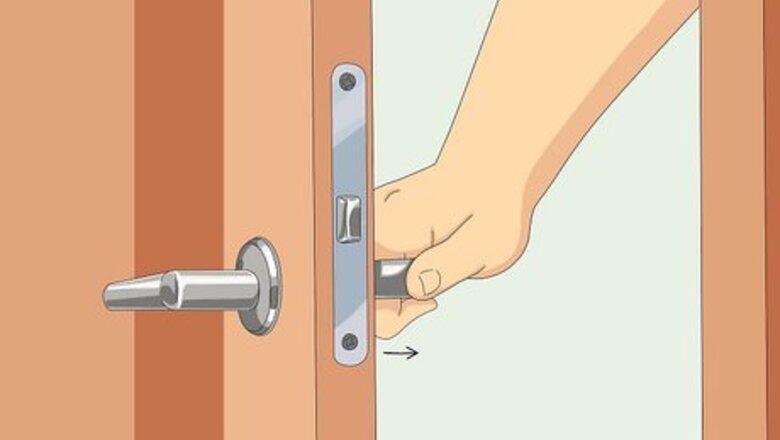
views
Preventing Your Cat From Going Out
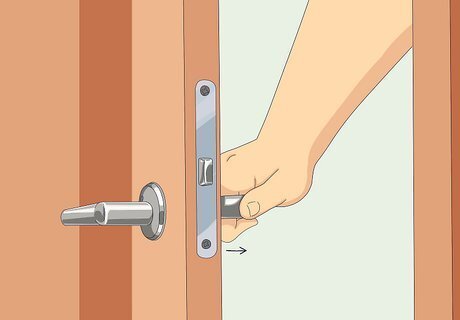
Close all doors and windows. Look around before opening any door to ensure your cat is not nearby, or at the very least, is preoccupied in playing with a toy. If you need to open a window, ensure it has a screen secured over it.

Limit access to exits. If possible, secure the space in which the door leading outside is situated. For instance, if your foyer has an inner door (leading into the home) and an outer door (leading outside), close the inner door and ensure your cat is not in the foyer with you before opening the outer door to leave. When opening windows that do not have window screens, first check the room to ensure the cat is not there, then close the door to the room in which you’re opening the window. If you don’t have a foyer, put the cat in a different room before leaving. If your windows can open from the bottom as well as the top, only open them from the top. This ensures that our cat cannot reach the open part of the window.
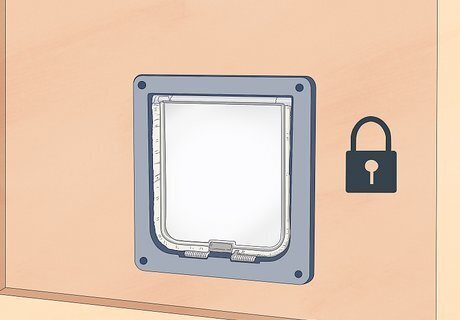
Install an electronic pet door. If you have a pet door in your house that you’re worried your cat might escape through, swap it out for an electronic pet door instead. This will allow you to lock the pet door during certain times and open it during other times. Some electronic pet doors allow you to equip one pet with an electronic signal key that will open the door for it, but not for the cat you want to keep indoors. Talk to a specialist at your local pet store for more information about your options. Watch your cat to make sure they do not wait for the pet with access to go through, then follow them out.

Use a pet proofing spray. Pet proofing sprays are motion-activated devices that emit an irritating but harmless liquid spray on your pet when it approaches an area you don’t want it near. To keep a cat indoors, place a pet proofing spray near windows and doors that you anticipate your cat might escape through. The exact method for using a pet proofing spray will vary according to the device you choose to utilize. Consult manufacturer directions before use. Generally, setting up a pet proofing spray unit is as easy as popping in a few batteries and turning the device on.
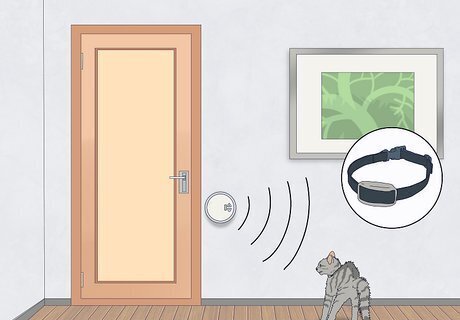
Train your cat to stay indoors with a pet proofing barrier. A pet proofing barrier is similar to a pet proofing spray, except that instead of getting sprayed by harmless liquid, your cat will hear a loud and startling beep. Place the pet proofing barrier near doors and windows that you fear your cat will escape from. Strap the sensor collar on your cat so that the sensor can detect when your cat is near. Eventually, your cat will learn to avoid the areas where it hears the beep.
Making the Indoors More Attractive for Your Cat

Give your cat plenty of toys to play with. To compensate for the lack of outdoor exploration and adventure, indoor cats will need toys to divert their attention and provide them with exercise and stimulation. Small, inexpensive toys like stuffed mice and plastic balls are often the most entertaining for cats, and can be played with even while you are away. Other toys – such as fishing-pole style toys that let you dangle a feather or piece of fabric in front of your cat – will require interaction with you. Using toys that require you to interact with the cat will help you to bond and create a better relationship with your pet. Battery-powered cat toys can be useful supplements for human interaction. If your cat wants longer or more intense play sessions than you can provide, battery-powered toys can help divert your cat's attention.

Make sure your cat can see out a window. Indoor cats will be much less bored and anxious if they have visual access to the outdoors. Make sure there is at least one uncluttered windowsill for the cat to sit on. It is best if the cat can access a window that receives direct sunlight, because this will prove more attractive to them and improve their mood.

Provide your cat with opportunities to forge. Buying or making foraging toys will give your cat a similar experience to hunting and foraging outdoors. These toys are containers with many holes or divots that your cat has to manipulate in order to get their food. This gives your cat an opportunity to use their brain and interact with their surrounding in a more rewarding way.
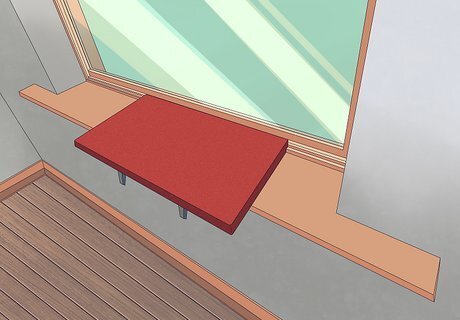
Give your cat a space of its own. If you have a window with a relatively deep sill, buy a padded perch and place it in front of the window. Alternately, invest in a window frame – a sort of clear, boxy unit similar to a windowsill air conditioner in which your cat can sit, hang out, and watch the world go by. Other cats might feel safest in their crates, so leave your cat’s crate or cage open at all times.

Provide a screened porch for your cat. If your cat can get some fresh air and survey its domain from an enclosed location, it’s a win-win for both you and the cat. If you don’t have a screened porch, consider building a “catio” – a large cage-like structure with many climbable surfaces. Your catio could be accessible directly from your home (via a side or rear door), or you could place it in your back yard. You can obtain catio building kits from most pet stores.

Set up a cat tree. A cat tree (sometimes called a “kitty condo”) is a vertical structure that provides your cat with opportunities for climbing, hiding, and jumping. Your cat will love navigating the cat tree. Set it up in an open space where your cat can freely move through and around it. You can easily obtain a cat tree at your local pet store.
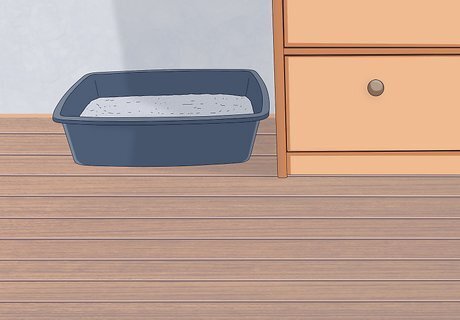
Position your litter box in a quiet, low-traffic area. If your cat feels uncomfortable for any reason using its litter box, it may attempt to escape outside to relieve itself. Make sure that wherever you place the litter box, your cat will have an unobstructed view of the whole room. In your home, the living room, bedroom, kitchen, or family room might qualify as a good location. Do not, for instance, place the litter box next to a noisy furnace or washing machine. Placing it in the corner of a room, likewise, will not make your cat want to use it.

Clean your litter box regularly. If your cat’s litter box is dirty and/or stinky, it might want to do its business outside. To prevent this, scoop feces from the litter box daily. Any time you observe clumping or wet litter, empty the litter and replace it. Generally, you’ll need to do this about twice each week. Don’t place the litter box in a closet or in the corner of a room, either, since your cat will feel trapped when using it. Additionally, do not place your cat’s litter box near its food dish. After all, just imagine how you’d feel dining right next to the place you go to the bathroom.
Altering Your Cat’s Behavior

Spay or neuter your cat. This is one of the easiest ways to keep a cat indoors, especially so if you have multiple cats. Neutering and spaying makes cats less territorial and inhibits their tendency to roam. Cats that have not been fixed will not adjust as well to being kept indoors, especially if they used to have access to the outside world. Plus, cats that have been neutered/spayed are more sociable and tend to have better health.

Train your cat to sit and stay away from exits. Place your cat in a location away from any doors or windows through which it might escape. Click a clicker with one hand and, at the same time, use your free hand to administer a treat. Say “Good cat” in a gentle, reassuring way and pet the cat. Repeat three or four times per training session, and hold several such training sessions daily. After a week or so, your cat should begin to associate the sound of the clicker with being in that location. From then on, perform one or two sessions daily for another week. After the second week, your cat should know where it needs to be when you enter and exit. From then on, click the clicker and administer two or three treats to occupy your cat just before you leave. Take the clicker with you or leave it right by the door. When you come home, click the clicker and lavish your cat with positive attention.

Walk your cat. Sometimes your cat just wants to satisfy its curiosity about the great big world outside. Place your cat in its harness and connect it to a leash. Take your cat for a walk around the block, or take it to the park to help it get in touch with its wild side. With luck, this will diminish your cat’s urges to go outdoors, at least for a few days.



















Comments
0 comment